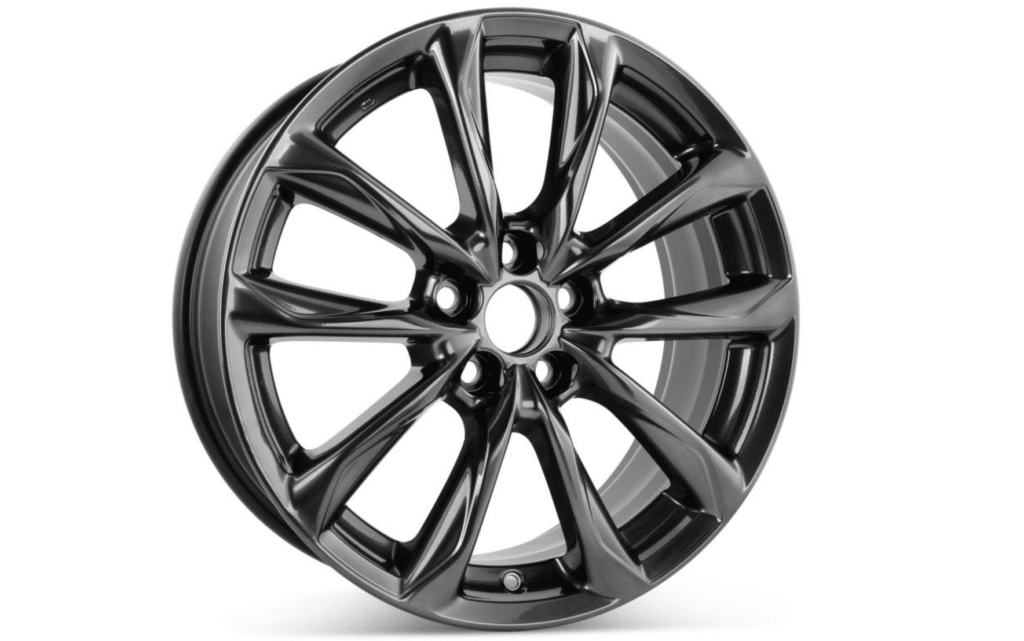Fellow car enthusiasts! I’m excited to dig into something that might seem small but makes a huge difference – Lexus lug patterns.
Here’s the deal: after spending years helping folks at my garage pick the right wheels, I’ve seen too many people make costly mistakes with lug patterns.
Getting the wrong lug pattern can leave you with useless wheels or, worse, safety issues. I’ll break down everything about Lexus lug patterns in simple terms – no fancy jargon, just straight talk.
In this guide, I’ll walk you through identifying your Lexus’s lug pattern, show you common patterns across different models, and share some money-saving tips for wheel shopping. Plus, I’ll throw in some real stories of what not to do (trust me, I’ve seen it all!).
Buckle up – let’s make wheel fitting a breeze!
What Is the Lug Pattern for A Lexus?

The lug pattern (also called bolt pattern) for Lexus vehicles varies depending on the model and year.
Most Lexus cars, like the IS, ES, and GS models, use a 5×114.3mm pattern, which means they have 5 lug nuts arranged in a circle with a diameter of 114.3mm. This is a common pattern shared with many Japanese vehicles.
However, some larger Lexus vehicles, particularly older SUVs like certain years of the LX models, use a 6×139.7mm pattern with 6 lug nuts.
It’s important to know your specific model’s lug pattern when buying new wheels or replacing parts.
The lug nut size and thread pitch can also vary between models, so it’s best to check your owner’s manual or a reliable automotive database for your exact vehicle’s specifications.
Getting these measurements wrong could mean buying wheels that don’t fit your car.
Understanding Lexus Lug Patterns and Their Compatibility

RX Series (RX 300, RX 350, RX 450h)
Most RX models from 1999-present use a 5×114.3mm bolt pattern. This pattern is widely used across many Toyota and Lexus vehicles, making wheel swaps relatively straightforward. The center bore is typically 60.1mm.
ES Series (ES 300, ES 350, ES 250)
Earlier ES models (pre-2001) used a 5x100mm pattern, while newer generations switched to 5×114.3mm.
When upgrading wheels, it’s crucial to verify your specific year as these patterns are not interchangeable without adapters.
LS Series (LS 400, LS 430, LS 460)
All LS models consistently use the 5×114.3mm pattern.
However, due to their luxury status, they often have larger wheel sizes and specific offset requirements for proper fitment.
IS Series (IS 250, IS 350, IS F)
The IS series primarily uses 5×114.3mm pattern. The high-performance IS F model uses the same pattern but may require specific wheel specifications due to larger brake calipers.
GX and LX Series
These SUV models use 6×139.7mm bolt patterns, different from other Lexus vehicles.
NX Series
All NX models use the standard Lexus 5×114.3mm pattern, making them compatible with many aftermarket wheels designed for other Lexus models.
RC and LC Series
These performance-oriented models use 5×114.3mm patterns, but often require specific wheel specifications due to their wide stance and performance requirements.
List of The Correct Lug Patterns for Different Lexus Models
| Lexus Model | Years | Lug Pattern | Center Bore |
|---|---|---|---|
| ES Series | 1992-Present | 5×114.3mm | 60.1mm |
| GS Series | 1993-2020 | 5×114.3mm | 60.1mm |
| IS Series | 2001-2005 | 5×114.3mm | 60.1mm |
| IS Series | 2006-Present | 5×114.3mm | 60.1mm |
| LS Series | 1990-Present | 5×114.3mm | 60.1mm |
| LX Series | 1996-Present | 5x150mm | 110mm |
| NX Series | 2015-Present | 5×114.3mm | 60.1mm |
| RC Series | 2015-Present | 5×114.3mm | 60.1mm |
| RX Series | 1999-Present | 5×114.3mm | 60.1mm |
| SC Series | 1991-2000 | 5×114.3mm | 60.1mm |
| SC Series | 2001-2010 | 5x100mm | 60.1mm |
| UX Series | 2019-Present | 5×114.3mm | 60.1mm |
| CT Series | 2011-2017 | 5x100mm | 60.1mm |
| GX Series | 2003-Present | 6×139.7mm | 106.1mm |
| LC Series | 2018-Present | 5×114.3mm | 60.1mm |
| HS Series | 2010-2012 | 5×114.3mm | 60.1mm |
Note: Always verify these specifications for your specific vehicle’s year and trim level, as there can be variations within model years. Some performance or special editions might have different specifications.
How to Identify the Correct Lug Pattern for A Specific Lexus Model
1. Vehicle Documentation Methods:
- Look up your specific model in the owner’s manual, which always lists the exact lug pattern specifications in the technical data section
- Check the vehicle registration card or documentation package, as many countries include wheel specifications in these documents
2. Physical Measurement Methods:
- Measure the distance between the centers of two opposite lug holes using a tape measure or ruler – this gives you the bolt circle diameter
- Count the number of lug holes to determine if it’s a 5-lug or 6-lug pattern
- Use a bolt pattern gauge tool, which is specifically designed to measure lug patterns and provides accurate readings
3. Digital Resource Methods:
- Visit Lexus’s official website and input your Vehicle Identification Number (VIN) to get exact specifications
- Use wheel-fit calculators on reputable auto parts websites by entering your model year and trim level
- Check automotive forums specific to your Lexus model, where enthusiasts often share detailed specifications
4. Professional Consultation Methods:
- Visit a Lexus dealership service department, where they can look up your exact specifications in their database
- Consult with a professional tire shop, which typically has access to comprehensive wheel fitment databases
- Have a wheel specialist physically inspect your vehicle to confirm the exact pattern before making any purchases
A Comparison Between Lexus and Other Brands’ Lug Patterns with Prices
| Brand | Common Lug Patterns | Average Lug Nut Price (per piece) | Full Set Price (20 nuts) |
|---|---|---|---|
| Lexus | 5×114.3mm, 6×139.7mm | $8-12 | $160-240 |
| BMW | 5x120mm | $12-15 | $240-300 |
| Mercedes | 5x112mm | $15-20 | $300-400 |
| Audi | 5x112mm | $14-18 | $280-360 |
| Infiniti | 5×114.3mm | $7-10 | $140-200 |
| Acura | 5×114.3mm | $6-9 | $120-180 |
| Genesis | 5×114.3mm | $8-11 | $160-220 |
Note:
- Prices are approximate and based on OEM (Original Equipment Manufacturer) parts
- Aftermarket options are typically 30-50% cheaper
- Some models within each brand may use different patterns
- Prices can vary based on location and dealer
- Most Japanese luxury brands use the 5×114.3mm pattern for compatibility
How to Maintain Lug Patterns on Your Lexus

- Regular Torque Checks: Check and adjust lug nut torque to factory specifications (usually 76-81 ft-lbs for most Lexus models) every 5,000 miles or after any wheel removal to prevent warping of the wheel hub and bolt pattern damage
- Proper Installation Sequence: Always follow the star or cross pattern when tightening lug nuts, working opposite corners to ensure even pressure distribution and prevent hub distortion, which can affect the lug pattern integrity
- Clean Thread Maintenance: Regularly clean the lug nut threads and wheel studs using a wire brush and apply a thin coat of anti-seize compound (avoiding the tapered seat) to prevent corrosion and ensure proper torque readings
- Visual Inspections: Examine lug holes in wheels for signs of elongation or wear during tire rotations, as damaged holes can indicate alignment issues or improper torque that could affect the lug pattern
- Professional Rotation Service: Have your tires professionally rotated every 5,000-7,500 miles to ensure proper wheel balancing and prevent uneven wear that could stress the lug pattern
- Quality Replacement Parts: Use only OEM or high-quality aftermarket lug nuts and wheels that match your Lexus’s exact specifications to maintain the integrity of the bolt pattern and prevent fitment issues
- Avoid Impact Tools: While convenient, limit the use of impact wrenches when installing wheels, as they can lead to over-torquing and damage to the lug pattern – use a calibrated torque wrench for final tightening
Conclusion
Thanks for sticking around! Understanding Lexus lug patterns might seem tricky at first, but I hope this guide has cleared things up for you.
Remember, getting it right isn’t just about making your wheels look good – it’s about keeping your ride safe and smooth.
If you found this helpful, check out my other guide on Ford Focus bolt patterns – you’d be surprised how these patterns can differ across brands! It’s quite interesting how each manufacturer has their own approach.
Got questions about your specific Lexus model? Drop a comment below, and I’ll help you figure it out. Your wheels aren’t something you want to guess about, and that’s why I’m here to help.
Stay safe on the roads, and make sure those wheels are properly secured! Catch you in the next guide.


